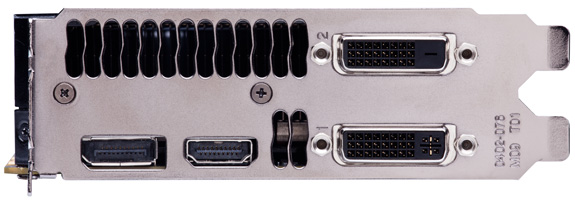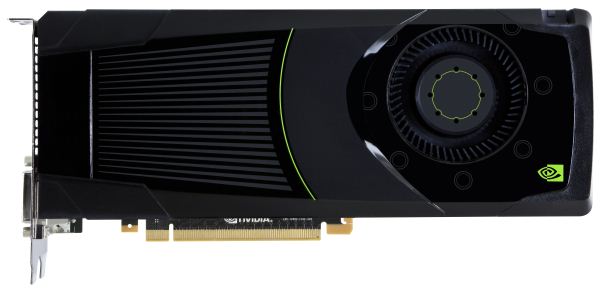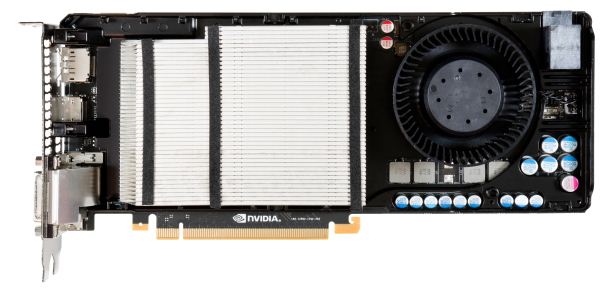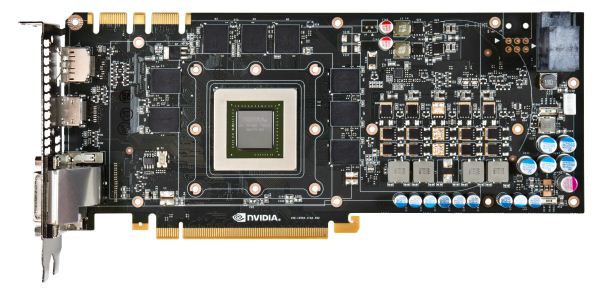NVIDIA GeForce GTX 680 Review: Retaking The Performance Crown
by Ryan Smith on March 22, 2012 9:00 AM ESTMeet the GeForce GTX 680
All things considered the design of the GeForce GTX 680 is not a radical departure from the GTX 580, but at the same time it also has some distinct differences owing to the fact that its TDP is some 50W lower than GTX 580.
Like the past GTX x80 cards, the basic design of the GTX 680 is that of a blower. A radial fan at the rear of the card sucks in air and pushes it towards the front of the card. Notably, due to a combination of card length and the fan position, the “wedge” around the fan has been done away with. NVIDIA tells us that this shouldn’t significantly impact the cooling of the card, particularly since it has a lower TDP in the first place, but when used in SLI it will remove some of the breathing room than the GTX 580 enjoyed.
Looking at the fan itself, compared to the GTX 580 the fan has been moved from the center of the card to the top of the card. This is due to NVIDIA’s port configuration, which uses a stacked DVI connector that consumes what would have normally been part of the exhaust vent on the GTX 580. We’ll get into the port configuration more in a minute, but for the moment the significance is that because the GTX 680 only has half a vent NVIDIA has moved the fan to match the vent, which is why the fan has been moved up.
On that note, the repositioning of the fan also had its own ramifications. Because the fan is now so close to the top and at the same time so close to the rear, NVIDIA went with a unique method of arranging the PCIe power sockets. Rather than having them side-by-side as we’ve seen on countless NVIDIA cards in the past, the sockets are stacked on each other in a staggered configuration. With the fan otherwise occupying the space that one of the sockets would take up, this configuration allowed NVIDIA to have two sockets without lengthening the card just to fit another socket. Overall this staggered design is not too difficult to work with, though with one socket facing the opposite way it might require some cable repositioning if you have a well maintained cable run.
Moving on, when we remove the shroud on the GTX 680 we see the fan, baseplate, and heatsink in full detail. NVIDIA is using an aluminum fin stacked heatsink, very similar to what we saw on the GTX 580. Underneath the heatsink NVIDIA is using a set of three heatpipes to transfer heat between the GPU and the heatsink. This is as opposed to the vapor chamber on the GTX 580, and while this setup doesn’t allow empirical testing, given the high efficiency of vapor chambers it’s likely that this isn’t quite as efficient, though to what degree we couldn’t say.
Finally, after removing the fan, baseplate, and heatsink, we can see the PCB in full detail. Unlike GF110 and GF114, GK104 is not capped with an IHS, allowing for the heatsink to directly come in contact with the GPU die. Meanwhile arranged around the GPU we can see the 8 2Gb GDDR5 RAM modules that give the GTX 680 its 2GB of RAM. These are Hynix R0C modules, which means they’re rated for 6GHz, the stock memory speed for the GTX 680. Overall the card measures 10” long with no overhang from the shroud, making it 0.5” shorter than the GTX 580.
Looking at the top of the card, as always we see the SLI connectors. Following in the footsteps of the GTX 580, the GTX 680 features 2 SLI connectors, allowing for up to 3-way SLI.
Meanwhile at the front of the card we see the I/O bracket. As we alluded to previously, the GTX 680 uses a stacked DVI design here; NVIDIA has done everything they can to keep the DVI ports at the very bottom of the card to avoid impeding airflow, but the upper DVI port still occupies roughly 40% of what would otherwise be the vent. Altogether the GTX 680 features 2 DL-DVI ports, a full size HDMI port, and a full size DisplayPort.

While NVIDIA has used DVI and HDMI ports for quite some time, this is the first time NVIDIA has included DIsplayPort on a reference design. Unfortunately we find that this ruffles our feathers a bit, although this isn’t strictly NVIDIA’s fault. As we’ve covered in the past, DisplayPort comes in both a full size and miniDP configuration – AMD in particular has used miniDP since the Radeon HD 6800 series in 2010. And while we’re happy to see DisplayPort finally make it into an NVIDIA reference design, the fact that it’s a full size DisplayPort is less than encouraging because at this point in time DisplayPort has largely been replaced by miniDP.
Ultimately the fault for this lies more with the VESA than NVIDIA, but it’s indicative of a larger problem in the DisplayPort community in that both full size DP and miniDP are equally valid and equally capable ports. While full size DisplayPort has the distinction of coming first, thanks in large part to Apple it has largely been displaced by miniDP as the most common variant on source devices. The problem with this is that both miniDP and DisplayPort are now in wide use; wide, redundant use.
At this point desktop computers and video cards coming with full size DisplayPorts is silly at best, and frustrating at worst. The laptop guys aren’t going to give up miniDP due to the space savings, and there’s no significantly good reason to use DisplayPort on desktops when miniDP offers the same functionality. We would rather see the PC industry standardize on miniDP across all source devices, and thereby eliminate any ambiguity with regards to what cables or adaptors are necessary. DisplayPort adoption has been slow enough – having 2 variants of the port on source devices only makes it more confusing for everyone.
Finally, while we’re on the subject of display connectivity we quickly took a look at how the idle clockspeeds of GTX 680 are impacted by the use of multiple displays. With 2 displays GTX 680 can utilize its full idle clocks, but only if both displays are connected via a TMDS type connection (DVI/HDMI) and run with identical timings. But if different timings are used or if one display is connected via DisplayPort, then the GTX 680 will shift to its low power 3D clocks. However if we expand that to 3 monitors and enable NVIDIA Surround, then the GTX 680 can operate at full idle regardless of whether DisplayPort is used or not.













404 Comments
View All Comments
mm2587 - Thursday, March 22, 2012 - link
Well I guess we can expect AMD to slash price $50 across the top of their line to fall back into competition. Competion is always good for us consumers.While theres no arguing gtx680 looks like a great card I am a bit dissapointed this generation didn't push the boundries further on both the red and the green side. Hopefully gk100/gk110 is still brewing and we will still see a massive performance increase on the top end of the market this generation.
Unfortunatly I predict the gk100 is either scrapped or will be launched as a gtx 780 a year from now.
MarkusN - Thursday, March 22, 2012 - link
As far as I know, GK100 got scrapped due to issues but the GK110 is still cooking. ;)CeriseCogburn - Thursday, March 22, 2012 - link
Competition isn't "the same price with lesser features and lesser performance". I suppose with hardcore fanboys it is, but were talking about reality, and reality dictates the amd card needs to be at least $50 less than the 680..Lepton87 - Thursday, March 22, 2012 - link
http://translate.google.ca/translate?hl=en&sl=...So they are basically even at 2560 4xMSAA yet anand doesn't hesitate to call GTX680 indisputable king of the heel. It's strange because 7950 is at least the same amount faster than 580 yet he only implicitly said that it is faster than 580.
http://www.hardwarecanucks.com/forum...review-27.h...
http://www.guru3d.com/article/geforce-gtx-680-revi...
http://translate.google.ca/translate...itt_einleit...
judging from those results OC7970 is at least as fast if not faster than OC680. Wonder why they didn't directly compare oc numbers, probably this wasn't in nvidia reviewiers guide. Also it's not any better in tandem
http://www.sweclockers.com/recension...li/18#pageh...
Sabresiberian - Friday, March 23, 2012 - link
Someone needs to learn how to read charts.What, did you post a bunch of links and think no one was going to check them out?
I'll quote one of your sources, HardwareCanucks:
"After years of releasing inefficient, large and expensive GPUs, NVIDIA's GK104 core - and by association the GTX 680 - is not only smaller and less power hungry than Tahiti but it also outperforms the best AMD can offer by a substantial amount. "
Personally, I don't much care who comes out on top today, what I want is the battle for leadership to continue, for AMD and Nvidia to truly compete with each other, and not fall into some game of appearances.
"Big Kepler" should really establish how much better it is than Tahiti, though I wouldn't be surprised if some AMD fanboys will still turn the charts upside down and backwards to try to make Tahiti the leader - just as they are doing now. Of course, the 7990 dual GPU board will be out by then, and they will claim AMD has the best architecture based on it performing better than Big Kepler (assuming it does).
I don't know what AMD has planned, but I hope they come out with something right after Kepler (September? Too long, Nvidia, too long!) that is new, that will re-establish them. Of course, then there's Maxwell for next year . . .
;)
jigglywiggly - Thursday, March 22, 2012 - link
it's slower in crysis, it's slowerSabresiberian - Friday, March 23, 2012 - link
Yeah? What if it's faster in Crysis 2?http://www.tomshardware.com/reviews/geforce-gtx-68...
(While I get why using a venerable bench that Crysis provides gives us a performance base we're more familiar with, the marks for Crysis 2 show why an older model may not be such a good idea. Clearly, the GTX 680 beats out the Radeon 7970 in most DX9 benchmarks, and ALL DX11 Crysis 2 benches.)
So, your troll doesn't just fail, it epic fails.
SlyNine - Saturday, March 24, 2012 - link
My problem is the tests are run without AA. I'd rather seen some results with AA as I suspect that would cause the 680GTX to trade blows with the 7970.On the other hand 1920x1200 with 2x AA is AA enough for me.
HighTech4US - Thursday, March 22, 2012 - link
In the review all the slides are missing.For example: instead of a slide what is seen is this: [efficiency slide] or this [scheduler]
HighTech4US - Thursday, March 22, 2012 - link
OK, looks like it just got fixed